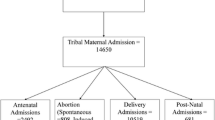Abstract
The sickle cell hemoglobinopathy is a major public health problem which causes high morbidity and mortality in India. Although the hematological and clinical profile of the patients is extensively studies. The reproductive outcome of mothers afflicted with sickle cell trait and disease is still unknown in India. In a retrospective study, we have examined the reproductive profile of 190 mothers afflicted with sickle cell, attending Medical Out-Patient Department at V.S.S. Medical College Hospital, Burla in Western Orissa, India during the year 1991–1992. Seventy-three mothers who were found normal after medical examination and were free from hemoglobinopathic disorders, anemia, jaundice, iron deficiency, etc. constituted the control group and 66 mothers with sickle cell trait and 51 with sickle cell disease formed the study group. The reproductive history was recorded for number of conceptions, fate of offspring, live birth, surviving children and childhood mortality. Hematological investigations and hemoglobin electrophoresis were done as per the standard procedure. There was no difference in mean number of livebirths per mother between controls and sickle cell trait mothers. But between the controls and sickle cell homozygotes (p<0.01), and sickle cell trait and disease (p<0.01) mothers, this mean number was significant. For abortions/miscarriages, the difference between controls and sickle cell homozygotes (p<0.001), and sickle cell trait and disease (p<0.01) mothers was highly significant. The number of stillbirths per mother in homozygous sickle cell mothers was higher (p<0.01) as compared to controls. There were significantly higher childhood deaths in sickle cell trait (p<0.05) and disease (p<0.05) mothers than in the controls. It seems that the sickle cell heterozygote and hemoglobin E heterozygote mothers are genetically better fit than the sickle cell homozygotes. Further, the sickle cell disease is clinically severer than the hemoglobin E disease in India probably due to molecular diversity.
Similar content being viewed by others
References
Balgir Rs. Current status of hemoglobinopathy and G-6-PD deficiency in Orissa: some further considerations.Man in Soc. 1992; 6: 67–78.
Kar BC, Devi S, Dash KC, Das M. The sickle cell gene is widespread in India.Trans Royal Soc Trop Med Hyg, 1987; 81: 273–275.
Balgir RS. Reproductive profile of mothers in relation to hemoglobin E geno-types.Indian J Pediatr 1992; 59: 449–454.
Dash S. A quick and simple method for routine haemoglobin electrophoresis.Indian J Pathol Microbiol 1978; 21: 839–841.
Weatherall DJ. The thalassemias. Edinburgh; Churchill Livingstone 1983; 36–37.
Balgir RS, Sharma SK. Distribution of sickle cell hemoglobin in India.Indian J Hemat 1988; 6: 1–14.
Balgir RS. The prevalence of sickle cell hemoglobinopathy in India. In: The Encyclopedia of Dravidian Tribes. T. Madhava Menon (Ed.). Trivandrum: The International School of Dravidian Linguistics 1996; 21–29.
Serjeant GR. Sickle cell disease. Oxford: Oxford University Press, 1985.
Joishy SK, Hassan K, Lopes M, Lie-Injo LE. Clinical, genetic and fertility studies of Indians with Bs-globin gene and the influence of HbS on Plasmodium falciparum malaria infection.Trans Royal Soc Trop Med Hyg 1988; 82: 515–519.
Author information
Authors and Affiliations
Rights and permissions
About this article
Cite this article
Balgir, R.S., Dash, B.P. & Das, R.K. Fetal outcome and childhood mortality in offspring of mothers with sickle cell trait and disease. Indian J Pediatr 64, 79–84 (1997). https://doi.org/10.1007/BF02795781
Issue Date:
DOI: https://doi.org/10.1007/BF02795781




